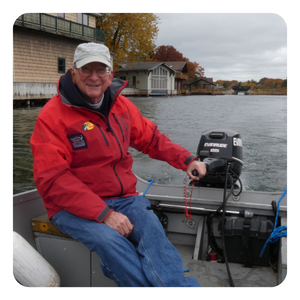Who Is Waterkeeper: John Peach, Upper St Lawrence Riverkeeper
By: Thomas Hynes

The St. Lawrence River is an international border, with Ontario, Canada on one side, and the U.S. state of New York on the other. It connects Lake Ontario, and the rest of the Great Lakes and Midwest, with the Atlantic Ocean, and the whole of the seafaring world. Suffice to say, the river is a crucial shipping channel for international commerce and trade.
Or it is for about nine months a year. The remainder of the year, typically between December and March, the river is frozen. In the 1970s, the U.S. Army Corps of Engineers proposed keeping the river open to winter navigation.
There are a few problems with winter navigation. For one, it’s not what nature intended. Ice-breaking and winter shipping causes significant damage to wildlife habitat. If a spill, fire, or other accident should occur, response is hampered by a lack of accessibility to the river’s icy conditions. Furthermore, the ‘de-iced’ clear passage of the frozen river is relatively narrow, raising the probability of accidents.
So in 1978, Save The River, the parent organization of Upper St Lawrence Riverkeeper, was formed to fight this misguided approach from the federal government.
One of the founding members was Abbie Hoffman, the renowned political activist and member of the Chicago Seven. Hoffman was going by the name of Barry Freed at that time, on account of being a fugitive of the law.
Save the River ultimately prevailed over the federal government and kept winter navigation at bay. The group’s concerns with shipping-related threats were not unreasonable or unfounded. In 1976, an oil tanker crashed in the river leading to what became known as ‘the slick of 76.’ It was a tragic event for the river and its wildlife. But it was also a galvanizing moment for locals.
John Peach has been the Upper St Lawrence Riverkeeper since 2018, but he distinctly remembers the slick of ‘76. A barge crashed upriver of his home. The vessel was then dragged for a while before the gash was even discovered. It resulted in thousands of gallons of heavy oil contaminating the river. It remains one of the largest inland oil spills in U.S. history.
“You can still see a band of oil in the granite that they couldn’t get off. If you go in there and take off some old boards from the boathouses, that oil is still there. It’s no longer weeping out, but it’s there,” says John. “You hear the dock builders and carpenters still talk about it. A number of my friends worked on the cleanup. Little was known about how to do that right.”
John Peach grew up in the Thousand Islands region along the St Lawrence River in upstate New York. He grew up on the river and right out of college began working in oceanographic research, specifically helping to rebuild and maintain four-person submersibles.
“I have traveled all around the world. I have been in a lot of the world’s most beautiful rivers and waters,” says John. “But this is a very special place. It gets into your DNA, it gets into your spirit. Walking down to the dock, throwing some water on my face. The fish, the fresh air, the friends, the wildlife. We are still able to drink the water off our dock. And I still believe that mixing a little river water with bourbon at night makes you healthier.”
As Upper St Lawrence Riverkeeper, John is trying to preserve as much of the area’s natural wealth as possible. One recent theater of that work is Blind Bay, home to over 50 species of fish, including the muskie, the river’s apex predator, which uses the bay as a breeding ground.
However, the U.S. Customs and Border Patrol have designs on dredging the bay in building their new training facility. From this, the Save Blind Bay campaign was born. John is quick to point out that an alternate facility exists nearby for the agency, and hopes the recent support of politicians will help protect the bay from development and dredging.
Upper St Lawrence Riverkeeper, and its parent organization Save The River, are also involved in education. Their curriculum annually reaches over 1,500 students in the North Country. There have also been excursions to Wellesley Island State Park and Rock Island Lighthouse. Students get introduced to the river ecosystem and learn all about water quality and the native wildlife living in the St. Lawrence watershed. They are also taught how to spot, report and reduce invasive species.
Looking beyond his own watershed, John relies on the experience and knowledge of his fellow Waterkeepers throughout the world to help him tackle future threats and challenges.
“There’s nothing we’ve talked about that others in Waterkeeper Alliance haven’t worked on,” says John. “To have access to those Waterkeepers, Jill Jedlicka down there at Buffalo Niagara Waterkeeper, Cheryl Nenn up there at Milwaukee Riverkeeper, on a formal and informal basis, it’s such a resource.”